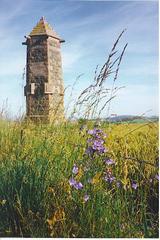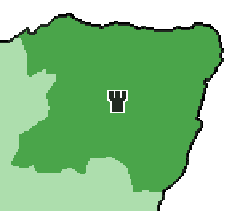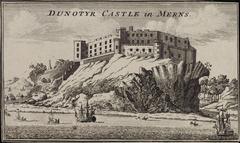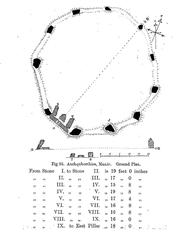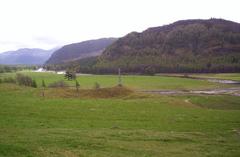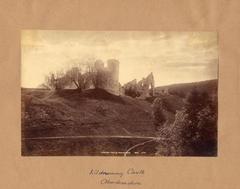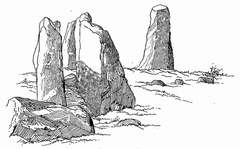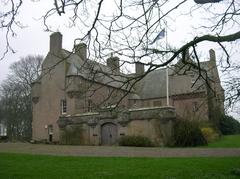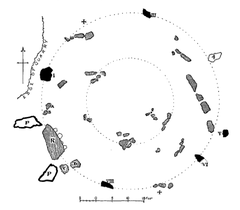
Dunnideer Stone Circle, 450M Nw Of Dunnideer Tower
Dunnideer Stone Circle: Visiting Hours, Tickets, and In-Depth Guide to Aberdeenshire’s Prehistoric Heritage
Date: 03/07/2025
Introduction
Dunnideer Stone Circle is a captivating prehistoric monument nestled in the rolling landscapes of Aberdeenshire, Scotland. As one of the region’s finest examples of a recumbent stone circle, it offers a tangible connection to the ancient peoples of northeast Scotland. This comprehensive guide equips you with essential details on the site’s history, cultural significance, visiting hours, ticketing, access, and nearby attractions, ensuring an enriching and respectful visit to one of Scotland’s most intriguing ancient sites (Historic Environment Scotland; VisitAberdeenshire).
1. Dunnideer Stone Circle: Historical and Archaeological Significance
Origins and Historical Context
Located approximately 450 meters northwest of Dunnideer Tower near Insch, Dunnideer Stone Circle belongs to the unique tradition of recumbent stone circles found primarily in Aberdeenshire and its surroundings. These monumental rings were constructed during the late Neolithic to early Bronze Age (circa 2500–1500 BCE) and are characterized by a large horizontal “recumbent” stone on the circle’s perimeter, flanked by two tall upright “flanker” stones. While only the recumbent and its flankers survive at Dunnideer, the original ring likely included several more stones (Historic Environment Scotland).
The site’s placement, overlooking the fertile Garioch countryside, suggests a deliberate alignment with both natural features and celestial events, echoing the ceremonial and astronomical importance attributed to such monuments (Canmore).
Archaeological Features
The recumbent stone at Dunnideer is a massive granite block approximately 2.84 meters long and 1.72 meters high, set in a northwest-southeast alignment typical of the tradition. The two flankers, one of which shows visible signs of historic damage and later re-erection, complete the surviving elements. While the exact number of original stones is unknown, recumbent stone circles in the region generally included 8–12 stones (VisitAberdeenshire).
Relationship to the Landscape
Dunnideer Stone Circle shares its hillside with a vitrified Iron Age hillfort and the medieval Dunnideer Tower, forming a multi-period archaeological landscape. This continuity of use and reverence reflects the site’s enduring significance, with each generation contributing to its layered story (The Modern Antiquarian).
2. Visiting Dunnideer Stone Circle
Visiting Hours and Ticket Information
- Access: The site is free to visit and open year-round. There are no ticket requirements, entry fees, or formal opening/closing times.
- Recommended Hours: Daylight visits are advised for safety and to best appreciate the monument and its views.
Getting There and Accessibility
- By Car: From Aberdeen, follow the A96 towards Insch. Roadside parking is available near the base of Dunnideer Hill; be considerate and avoid blocking farm entrances.
- By Public Transport: Insch is served by regular trains on the Aberdeen-Inverness line and local bus services. The stone circle is approximately a 20-minute walk from Insch station (ScotRail; Traveline Scotland).
- On Foot/Bicycle: The area offers pleasant rural walking and cycling routes.
- Pathways: The approach is across grassy slopes and farmland, with no formal paved paths. The terrain is uneven and can be muddy; sturdy footwear is essential.
- Accessibility: The site is not wheelchair accessible due to uneven ground.
Facilities
There are no onsite facilities, visitor centers, or toilets. The nearest amenities are in Insch village. Bring water, snacks, and dress appropriately for Scotland’s variable weather.
Visitor Etiquette
- Respect the Stones: Do not climb or lean on the stones; the site is a legally protected Scheduled Monument.
- Leave No Trace: Take all litter home, avoid damaging vegetation, and follow responsible tourism guidelines (Scottish Outdoor Access Code).
- Dogs: Welcome, but must be kept on a lead, particularly near livestock.
3. Enhancing Your Visit: Insights and Nearby Attractions
Onsite Experience
The tranquility of the site, combined with panoramic views and the imposing presence of Dunnideer Tower on the skyline, creates a unique atmosphere. Wildlife is abundant, and the site’s changing mood through the seasons makes each visit distinct.
Interpretation and Signage
There is minimal onsite signage; interpretation boards are usually at parking areas. For deeper context, use audio guides or mobile apps, or consult resources before your visit.
Photography
Dunnideer Stone Circle is highly photogenic, especially at sunrise or sunset. Drone use may require permission due to the site’s protected status (Canmore).
Nearby Attractions
- Dunnideer Tower: A medieval ruin atop the hill, just a short walk from the stone circle.
- Other Stone Circles: Aberdeenshire is rich in recumbent stone circles, such as Loanhead of Daviot and Easter Aquhorthies, perfect for a day of exploration (VisitAberdeenshire).
- Insch Village: Offers shops, cafes, and historical context.
4. Responsible Tourism and Site Protection
Dunnideer Stone Circle is a Scheduled Monument, protected by law. Please:
- Stay on Established Paths: Avoid trampling crops or disturbing livestock.
- No Fires or Camping: Open flames and overnight stays are prohibited.
- Support Local Communities: Park considerately and support local businesses (VisitAberdeenshire Responsible Tourism Toolkit).
5. Frequently Asked Questions (FAQ)
Q: What are the visiting hours for Dunnideer Stone Circle?
A: Open year-round; visit during daylight for safety.
Q: Is there an entrance fee or ticket required?
A: No, access is free and unticketed.
Q: Are there facilities onsite?
A: No; nearest amenities are in Insch village.
Q: Is the site accessible for wheelchairs or those with limited mobility?
A: The terrain is uneven and not suitable for wheelchairs.
Q: Are guided tours available?
A: No regular tours, but local heritage groups may offer events in summer—check with local tourism offices.
Q: Can I bring my dog?
A: Yes, but keep on a lead, especially near livestock.
6. Stone Circles of Aberdeenshire: A Broader Perspective
Aberdeenshire is home to the highest concentration of recumbent stone circles globally, with nearly 150 known sites, 71 of which are classified as RSCs (VisitAberdeenshire; Cambridge Scholars PDF). These circles share common features—recumbent and flanker stones, graded uprights, and strategic landscape positioning—but each is unique in its history and setting.
Visitor Tips for Stone Circles in Aberdeenshire:
- Most are freely accessible and open year-round.
- Terrain varies; check local access details.
- Combine visits to several circles for a thematic day out.
- Respect their protected status and help conserve these ancient sites for future generations.
7. Practical Travel and Safety Tips
- Check Weather: Scottish weather is unpredictable—bring waterproofs and layers (Met Office).
- Navigation: Mobile coverage may be limited; carry a map or GPS.
- Inform Others: Let someone know your plans if walking alone.
- Wildlife: Be mindful of livestock and seasonal wildlife activity.
8. Visuals and Interactive Media Suggestions
- Include high-quality images of the circle with alt text such as “Dunnideer Stone Circle recumbent stone in Aberdeenshire.”
- Embed an interactive map with the location and nearby attractions.
- Consider linking to virtual tours or drone footage if available.
9. Further Information and Resources
- Canmore: Dunnideer Stone Circle
- Historic Environment Scotland
- VisitAberdeenshire
- Live Breathe Scotland: Stone Circles in Aberdeenshire
- Scottish Outdoor Access Code
- VisitScotland: Responsible Tourism
- Garioch Walks: Hill of Dunnideer Circular PDF
- WalkHighlands: Hill of Dunnideer
- Traveline Scotland
- Cambridge Scholars sample PDF
10. Conclusion and Call to Action
Dunnideer Stone Circle stands as a powerful reminder of Scotland’s ancient past, offering visitors an evocative blend of historical intrigue, scenic beauty, and cultural depth. Its accessibility, unspoiled setting, and proximity to other heritage sites make it an ideal destination for travelers seeking to connect with Scotland’s prehistoric roots.
Plan your visit today—use official tourism resources and consider downloading the Audiala app for digital audio guides that enrich your onsite experience. Share your journey with others, and remember to respect and protect these fragile monuments for future generations.
Sources
- Dunnideer Stone Circle: Visiting Hours, Tickets, and Historical Significance in Aberdeenshire, 2025, Historic Environment Scotland (Historic Environment Scotland)
- Dunnideer Stone Circle Visiting Hours, Tickets, and Guide to Aberdeenshire Historical Sites, 2025, Canmore (Canmore)
- Aberdeenshire Stone Circles: Visiting Hours, Tickets, History & Nearby Attractions, 2025, VisitAberdeenshire (VisitAberdeenshire)
- Dunnideer Stone Circle Visiting Hours, Tickets, and Practical Guide to Aberdeenshire Historical Sites, 2025, Live Breathe Scotland (Live Breathe Scotland)
- The Modern Antiquarian: Dunnideer, 2025 (The Modern Antiquarian)
- VisitScotland Responsible Tourism, 2025 (VisitScotland Responsible Tourism)
- Cambridge Scholars sample PDF (Cambridge Scholars PDF)
- Garioch Walks: Hill of Dunnideer Circular PDF (Garioch Walks PDF)
- WalkHighlands: Hill of Dunnideer (WalkHighlands)
- VisitAberdeenshire Responsible Tourism Toolkit (VisitAberdeenshire Responsible Tourism Toolkit)

